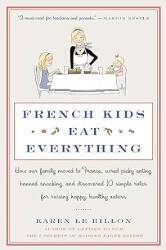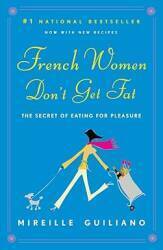
French School Lunches
What do French schoolchildren eat for lunch?
French school lunches
are very different from those in most other
countries, especially those in the U.S.
French children are in school all day, even in the
maternelle (roughly equivalent to U.S. kindergarden)
and in the pre-school before that.
Education covers life at large, including nutrition and meals.
For the French, learning how to eat a meal and
appreciate diverse foods
is like learning how to read, write and do arithmetic.
Lunch is the main meal of the day for children.
In French schools this meal has four courses:
- Vegetable starter: leafy green salad or sliced or grated vegetables.
- The warm main dish, which includes a vegetable side dish. The cooks know how long to cook asparagus with flavor so the kids will love it. The children are introduced to a broad variety of foods, their preparation, and the social interaction of mealtime.
- Cheese course.
- Dessert is fresh fruit four times a week with a sweet treat on the fifth day.
The Ministry of National Education requires that the children sit at the lunch table for at least 30 minutes, in order to eat a civilized meal. The municipal government is responsible for operating the cantine, now more appropriately called the restaurant scolaire, and adhering to the national nutritional requirements which include:
- Within any four-week period (20 meals), only a maximum of four main dishes and three desserts can be high fat.
- Similarly, fried food is limited to four meals per month, likely the same four high-fat main dishes.
- Ketchup can only be served once per week, typically with the once-per-week fries, and only a limited amount provided with the meal. Many schools simply don't serve the high-sugar high-salt ketchup at all.
- No sweetened and flavored milk, water is served.
- No daily menu may be repeated within a month.
The municipal government can set prices within the constraints of the national law's maximum limit and sliding scale. The result is that, on average, a school lunch costs something like €2.30–2.80. The very wealthiest families might pay €5.40 per meal while those with the lowest of incomes pay €0.15 and free meals are available for those who can't pay.
Vending machines are prohibited in French schools. Parents are strongly discouraged from sending their children to school with sack lunches, and very few do.
All this comes from the Ministry of National Education, formally known as the Ministère de l'Éducation nationale, de la Jeunesse et de la Vie associative, indicating the sports and other physical activity are also considered a crucial part of French life.

Above we see what was formerly l'École Communale de Garçons or the Public School for Boys in the 12th Arrondissement of Paris. It's along Avenue Daumesnil facing the Promenade Plantée, near Gare de Lyon.
The case to the left of the door has the week's menu posted, as required by law. Let's check it out. This school also lists its breakfasts. You have to wonder if they ever offer the students French toast for breakfast. Choosing the right how to cook French toast recipe can make French toast a healthier option for breakfast.
| Lundi 14 Mai | Monday 14 May |
|
|
|
|
| Mardi 15 Mai | Tuesday 15 May |
|
|
|
|
| Mercredi 16 Mai | Wednesday 16 May |
|
|
|
|
| Jeudi 17 Mai | Thursday 17 May |
| Ferie | Holiday (Ascension Day) |
| Vendredi 17 Mai | Friday 17 May |
|
|
|
|



This next school is in the 18th Arrondissement of Paris, going up the hill from the Pigalle Métro station toward Montmartre.

The case near the entrance holds various announcements, including four weeks' of menus.
The dark plaque above is in memory of the students from this school who were deported by the Germans and killed in extermination camps, with the assistance of the Vichy puppet government. About 700 children from the 18th Arrondissement alone were killed in the German death camps.

| Lundi 7 Mai | Monday 7 May |
|
|
| Mardi 8 Mai | Tuesday 8 May |
| Ferie | Holiday — V-E Day, German troops agree to an unconditional surrender on this day in 1944. |
| Mercredi 9 Mai | Wednesday 9 May |
|
|
| Jeudi 10 Mai | Thursday 10 May |
|
|
| Vendredi 11 Mai | Friday 11 May |
|
|
The second week's menu is too hard to read in my picture, it was behind some old tape and I didn't notice it at the time. Let's move on to the next one.


| Lundi 21 Mai | Monday 21 May |
|
|
| Mardi 22 Mai | Tuesday 22 May |
|
|
| Mercredi 23 Mai | Wednesday 23 May |
|
|
| Jeudi 24 Mai | Thursday 24 May |
|
|
| Vendredi 25 Mai | Friday 25 May |
|
|

| Lundi 28 Mai | Monday 28 May |
| Holiday | Holiday |
| Mardi 29 Mai | Tuesday 29 May |
|
|
| Mercredi 30 Mai | Wednesday 30 May |
|
|
| Jeudi 31 Mai | Thursday 31 May |
|
|
| Vendredi 1 Juin | Friday 1 June |
|
|

Briare is a town with a population of about 5,660, about an hour by regional train south of Paris, on the Loire River.
The municipal school in Briare is in a rather uninteresting building. I believe it is housed in former warehouses along the Briare Canal.
The canal's construction started in 1604, and it opened for transport in 1642. It was the first European summit level canal built with pound locks. Those are the now-standard locks with gates at both ends controlling the water level within the pound, the enclosed space between the gates. The design was first constructed by the Chinese engineer and government official Qiao Weiyo in 984. In Europe, the design first appeared in the Netherlands.
This World War I monument is along the canal, the school is in the background directly behind.

| Lundi 14 Mai | Monday 14 May |
|
|
| Mardi 15 Mai | Tuesday 15 May |
|
|
| Mercredi 16 Mai | Wednesday 16 May |
|
|
| Jeudi 17 Mai | Thursday 17 May |
| Ascension | Ascension |
| Vendredi 17 Mai | Friday 17 May |
|
|

There is a school very close to the large cathedral in the old city of Nevers.




The École Jean Paul Riopelle is the elementary school in Vétheuil along the Seine river between Paris and Rouen. The school group shown at the top of this page was returning to here for their lunch.

| Mardi 29 Mai | Tuesday 29 May |
|
|
| Jeudi 31 Mai | Thursday 31 May |
|
|
| Vendredi 1 Juin | Friday 1 June |
|
|

| Lundi 4 Juin | Monday 4 June |
|
|
| Mardi 5 Juin | Mardi 5 June |
|
|
| Mercredi 6 Juin | Wednesday 6 June |
| Holiday | The anniversary of the D-Day landings in 1944 are a national holiday in France. |
| Jeudi 7 Juin | Thursday 7 June |
|
|
| Vendredi 8 Juin | Friday 8 June |
|
|

In the U.S., Time magazine's "School Lunches in France: Nursery-School Gourmets" seems to have been one of the articles that drew significant attention in America to French school menus.
Related to this, see the CBS News story "Why my child will be your child's boss", which explained how Swiss school children are regularly taken into the forest and allowed — no, required — to use saws.
Lenore Skenzay's book Free-Range Kids describes how a U.S. high school principal threatened to suspend a group of seniors (that is, 18 years old, in their final year of school) for the "dangerous act" of riding their bicycles to school, and a group of parents protested because their 17- and 18-year old children were sent home from school on a train without an adult supervisor. Meanwhile Swiss children as young as three are given saws to play with, and their kindergarten system advises parents to let 4- and 5-year-old children walk to school alone.

A French school group crosses the main street through the center of Avignon's old town. They are managing to cross the road without the aid of multiple adults in reflective vests stopping traffic. Incroyable!
Then there are American school lunches and their concept of ketchup as a vegetable and frozen pizza as a vegetable.
Ronald Reagan's FY1982 budget proposed US$57 billion in spending cuts, This budget was modified and passed as the Gramm-Latta Budget, cutting US$1 billion from the school lunch program while significantly increasing military spending.
The U.S. Department of Agriculture or USDA was then tasked with the impossible task of maintaining nutritional requirements for school lunches despite the loss of a billion dollars in funding.
On September 3, 1981, the U.S. Secretary of Agriculture announced a joint proposal by the USDA and the Food and Drug Administration to reclassify ketchup and pickle relish as vegetables. Public outrage led to the eventual retirement of this specific proposal. However...
By 2011, USDA standards accepted just two tablespoons or 30 ml of tomato paste as counting for a full serving of vegetables. This allows a slice of cheese and meat pizza to also count as a full serving of vegetables.
The USDA wanted to change this to require at least a half-cup or 118 ml of tomato paste before counting it as a full serving of vegetables, also requiring more green vegetables and limiting the amount of potatoes served to one cup per week and thus significantly cutting back on the amount of French fries.*
The U.S. Congress would have nothing to do with that healthy nonsense, and quickly passed a bill barring the USDA from changing its existing nutritional guidelines.
This was an enormous victory for manufacturers of pre-processed French fries and frozen pizza. The American Frozen Food Institute is a trade association that lobbied heavily and successfully on behalf of frozen pizza manufacturers including ConAgra and Schwan Food Company, and French fry manufacturers McCain Foods Ltd and J.R. Simplot Company, the last of which was already a supplier to McDonald's. Meanwhile the actual French people, including their school children, eat only a tiny fraction of the amount of "French fries" consumed by their American equivalents.




